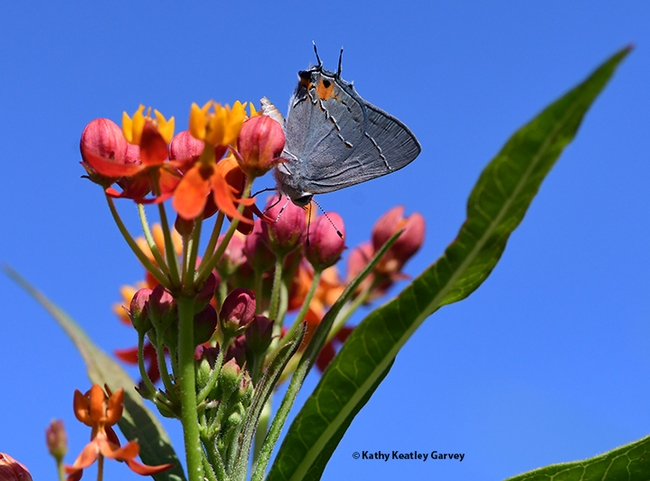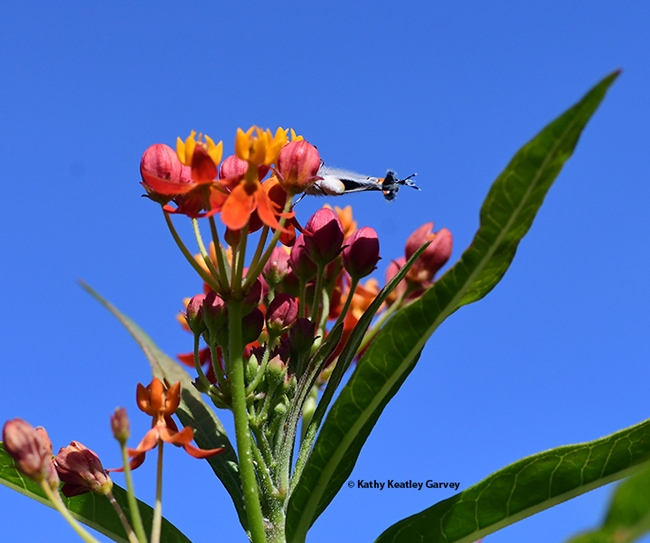- Author: Kathy Keatley Garvey
Where are the monarch butterflies? They're MIA on the four species of milkweed in our Vacaville pollinator garden
But milkweed attracts other insects, including honey bees, carpenter bees, bumble bees, assassin bugs, syrphid flies, leafcutter bees, Anthophora (genus) bees, wasps, praying mantids, and butterflies, including Gulf Fritillaries, Agraulis vanillae, and gray hairstreaks, Strymon melinus. And yes, arthropods such as crab spiders and orbweavers visit, too.
On Sept. 19, we witnessed a gray hairstreak laying eggs on the buds of a tropical milkweed, Asclepias curassavica, which we planted in a container with another milkweed, butterflyweed, A. tuberosa. (Yes, we give the monarchs a choice; we also offer them showy milkweed, A. speciosa, and narrowleaf milkweed, A. fascicularis, and we cut back the A. curassavica before the fall migration, as noted entomologists recommend.)
Butterfly guru Art Shapiro, UC Davis distinguished professor of evolution and ecology, says this about the gray hairstreak on his website, Art Shapiro's Butterfly Site:
"This is one of the most polyphagous butterflies known, recorded on host plants in many families. Its most frequent hosts in our area are mallows, including the weedy species of Malva; legumes, including Spanish Lotus (Lotus purshianus), Bird's-Foot Trefoil (Lotus corniculatus), White Clover (Trifolium repens) in lawns, Alfalfa (Medicago sativa) and many others;and Turkey Mullein (Eremocarpus or Croton setigerus, Euphorbiaceae)."
So, we mentioned the gray hairstreak laying eggs on the buds of the milkweed. "Is this a host plant, too?"
"Apparently on the flower buds! Never before recorded--in fact, I have no records on Asclepiadaceae/Apocynaceae at all," Shapiro said. "They lay on Callistemon (bottlebrush) too..."
Meanwhile, update: no monarchs, no eggs. We're still waiting.
But "yes" on the gray hairstreak, Strymon melinus, and "yes" on her eggs.





The Xerces Society and California Native Plant Society and Santa Monica Mountains has asked people not to plant this.
The Xerces Society and California Native Plant Society and Santa Monica Mountains has asked people not to plant this.
How many butterflies, monarchs or otherwise, have you successfully hatched? What varieties of Asclepias are you growing in your yard? What do the monarchs feed on when they migrate to Central America? Does someone plant California native milkweed down there?
Kathy was asked by UC Davis scientists to help in hatching monarchs, which she successfully accomplished, with more that 100 sent on their way in the last year.
Words and photo by Kathy Keatly Garvey
"Monarchs are on life support. Winter breeding is underway in Bay Area. Both Art Shapiro of #ucdavis and David James of #wsu agree that #tropical milkweed, Asclepias curassavica, is not to blame for the declining monarch population. Images taken last summer in Vacaville, Calif. #BugSquad https://bit.ly/3e40yT6"
This is what Monarch butterflies who have wintered over look like (see above article). They are faded and worn. They have waited and now it is time for them to fly forward and start a new generation.
California records on Asclepias curassavica on the CalFlora site, one for 1909 for San Luis Obispo. That is over 100 years, and only now is it being blamed for causing OE outbreaks. In his book “The Monarch Butterfly,” Dr. Fred Urquhart posted a photo of small football shaped scales. He thought they were just that. But, the shape is unmistakable, he found OE spores. Monarchs have been dealing with OE for over a century. Back 100 years ago there were lots more Monarchs in California than there are today.
There are many factors, but the loss of milkweed in California is a huge factor. It is not the time to label any milkweed as detrimental. How much tropical milkweed has been pulled out or cut back when it was needed by people following certain scientists and conservation groups? I advocate planning natives, but am against pulling out all tropicals until your natives are mature. Please be aware that native milkweeds also collect OE spores. This elimination of tropical milkweed must stop, it has become harmful. We can see that harm by the severe decline in the Monarch population in California. A healthy first generation is needed to spread out and repopulate during the breeding season. Tropical milkweed provides Monarchs with a resistance to OE and more protection due to making them more toxic. Another bonus less tachinid flies are produced when Monarchs eat tropicals. Why can't we have natives and tropical, especially if we manage both?
Historical records for A. curassavica in California: http://ucjeps.berkeley.edu/cgi-bin/get_consort.pl?dups=CDA5518%20SD239561%20UCR195997%20SD240828%20UCR235513%20UCR179772%20UCR194084%20UCR262010%20UC455085%20UC1313033
1909 record: http://ucjeps.berkeley.edu/cgi-bin/new_detail.pl?UC455085&YF=0
More Information: http://ucjeps.berkeley.edu/cgi-bin/get_cpn.pl?Asclepias+curassavica